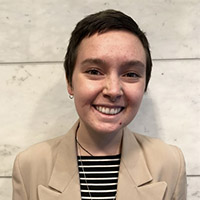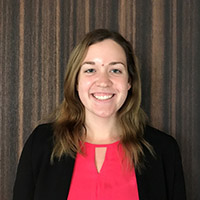By Izabel Aguiar and Jessica Deters
“What does that mean?” we often asked ourselves as we left mathematically-intensive sessions at the Joint Mathematics Meetings (JMM). Though we do not have Ph.D.s, we have a solid understanding of applied mathematics, and yet many talks left us puzzled. While this is incredible motivation to learn more mathematics so these talks become more accessible, and while the talks at JMM are often targeted to specialists in that field, we frequently found ourselves reflecting on the importance of effective communication for mathematicians and scientists. As we attended more sessions and talked with attendees, effective communication emerged as an increasingly important issue to discuss.
“Can you explain it to your grandmother?” Carla Cotwright-Williams asked during a joint SIAM-MAA-AMS panel on multiple pathways to mathematical careers in business, industry and government at the Joint Mathematics Meeting on January 5. The panel repeatedly emphasized the importance of effective communication, that is, presenting mathematical work and topics in a way that everyone can understand. Cotwright-Williams, who earned her Ph.D. from the University of Mississippi and now works at the U.S. Social Security Administration, emphasized the necessity of using plain language when communicating mathematical work, especially to a non-technical audience. She offered the “grandmother” trick as a way to ensure the language is accessible and understandable.
Communicating math effectively is important to not only reach a non-technical audience but also to communicate with peers. Photo credit: Wikimedia Commons
The necessity of plain language extends beyond industry contexts. The use of accessible language when communicating mathematics to a non-technical audience is vital to both the preservation and continued growth of our field. The work that we do as applied mathematicians is not only applicable to an ‘elite’ world of intellectual number-crunchers. The impact of our research unsurprisingly extends to the members of the public who experience the physical world, the design of transportation systems, and the impact of epidemics. In some ways, those who are not technically fluent are our clients, and we must succeed in necessary exchanges of information in order to convince our clients of the necessity of applied mathematics. By doing so, we not only share important insights about our shared worlds, but have the opportunity to reach and inspire the untapped mathematical talents waiting to change the universe.
Anna Haensch reaches this non-technical audience through her podcast “The Other Half,” in which she and friend Annie Rorem apply mathematical thinking and logic to everyday topics like driving, weather, and even racism. Haensch, a professor of mathematics at Duquesne University, believes the podcast can reach those with an aversion to math and show them how relatable aspects of math reveal themselves in everyday life. By letting go of the idea of perfect mathematics and focusing on public engagement, Haensch and Rorem are able to unveil the beauty of mathematics to all. At its core, mathematics is a lens through which to view the world. Right now, it seems this lens is only accessible to those who study the secrets of mathematics. Haensch and Rorem’s work offers this lens to everyone. Mathematics exists to explain the world around us, so why not let the world around us in on the underlying math and mathematical thinking?
Although effective communication is essential to connect with non-mathematicians, the intelligible articulation and exchange of ideas within the mathematical community is crucial as well. This clear articulation falters when the competitive nature of mathematicians emerges, which happens all too frequently in environments like JMM. Whereas the intention of the conference is to facilitate and nourish the sharing of knowledge, pride and confidence in one’s research can easily be misinterpreted as a boastful display of arrogance. This is a result of miscommunication and can feed competition and hinder the transfer of knowledge between colleagues. This, however, can also be easily avoided through patient and thorough explanations. The most impressive communicators ask questions before assuming that their audience has background knowledge of a topic. They take the time to check in with their audience, read the non-verbal cues, and adjust their scope or description accordingly. They ask for and are receptive to the feedback of others, and provide it to their peers as well. By actively valuing these skills, we can foster an even stronger community and create a space where collaboration is seamless.
Tim Chartier, recipient of a national teaching award from the Mathematical Association of America and professor at Davidson College, shared his experiences with these skills at a panel on alternative communication at JMM. Unlike most JMM attendees, Chartier is both a professional mathematician and a professional mime. He and his wife, Tanya Chartier, have spent the past decade developing what they call ‘Mime-atics’, a creative way of communicating mathematics. The Chartiers perform their shows everywhere, from elementary schools to renaissance festivals, to the Mathemati-con at JMM, in hopes that the inherent creativity and imagination of mathematics will be conveyed to others. Although Mime-atics was initially developed with the aim of communicating mathematics to non-mathematicians, the side effects have aided in his communication with his peers, as well. As someone who is professionally trained to communicate without words, it is unsurprising that Chartier is also perceptive to the non-verbal cues of those around him. At the panel, Chartier recalled a performance where he had to change his plan because he noticed the closed-off body language of his audience. He was able to pick up on their folded arms and hunched shoulders and adapt his show to ensure that his message would be effectively communicated. Although many of us will never have the opportunity to become a professional mime, we can adopt some of the techniques he’s learned. By reading the non-verbal cues of our peers and being willing to adapt the content of our presentations accordingly, we can begin to change how mathematics is communicated.
Though changing how the world communicates will take time, we discovered a few strategies to help in the meantime. For example, when asked by a new acquaintance about your research, it helps to answer them in a simple and accessible way. During the questions session of the next talk that leaves you confused, challenge yourself and the speaker by asking, “If you had to explain your talk to a third-grader, what would you say?” In every technical interaction, set the intention to practice effective communication and patience before speaking with a peer, your mathematical nemesis, or curious third-grader. The practice of your effective communication will eventually spread, and hopefully at next year’s JMM we won’t be having the same discussion.
We must acknowledge that not all incomprehensible talks, articles and lectures indicate poor communication. That being said, we should not accept confusion as the norm. We must challenge ourselves and others to set a standard of clarity, and keep searching for answers, one question at a time.
 |
Izabel Aguiar is a student at the Colorado School of Mines and is currently pursuing her bachelor’s in statistics, her master’s in computational and applied mathematics, and her Secondary Teaching Licensure. Izabel is passionate about interdisciplinary research, the power of education, and the importance of effective communication. |
 |
Jessica Deters is a senior at Colorado School of Mines completing her BS and beginning her MS in Applied Mathematics and Statistics. She's passionate about effective communication of mathematics to the masses and increasing diversity in STEM. |